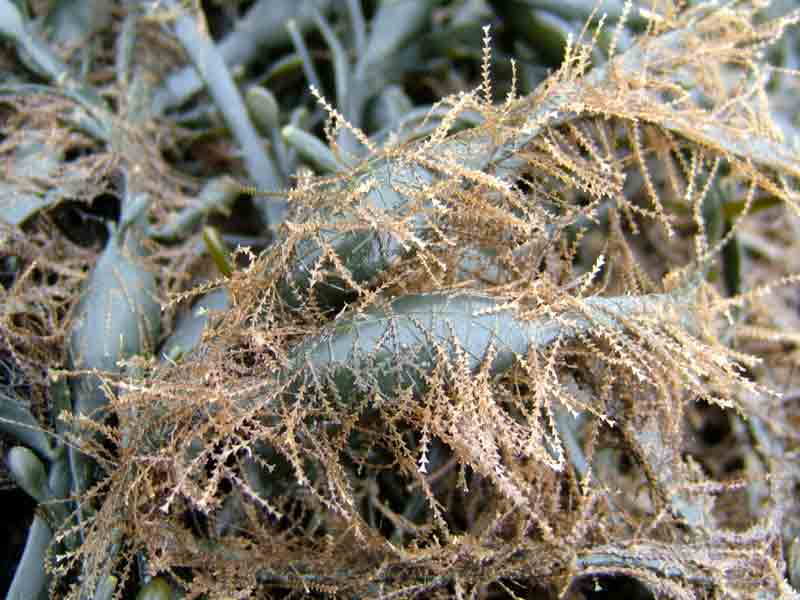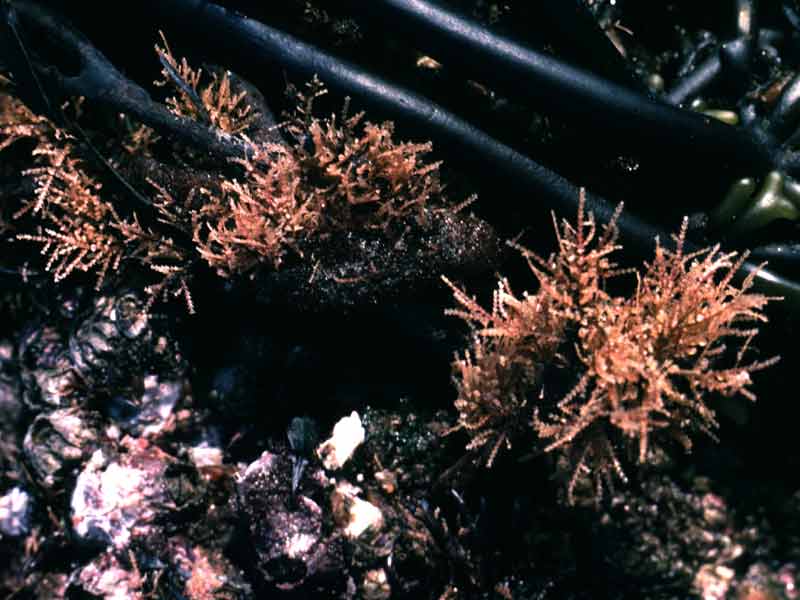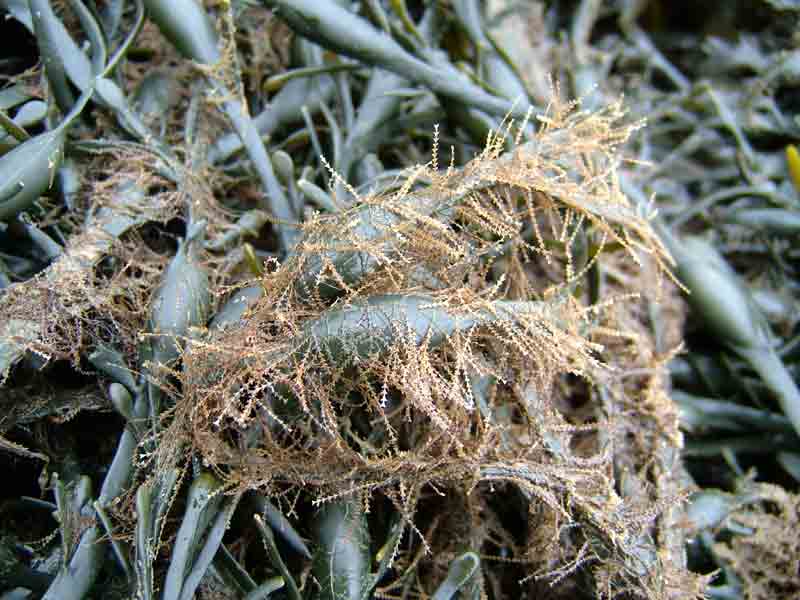Garland sea fir (Dynamena pumila)
Distribution data supplied by the Ocean Biodiversity Information System (OBIS). To interrogate UK data visit the NBN Atlas.Map Help
| Researched by | Charlotte Marshall | Refereed by | Admin |
| Authority | (Linnaeus, 1758) | ||
| Other common names | Minute hydroid, Minute garland hydroid, Garland hydroid | Synonyms | - |
Summary
Description
A small hydroid rarely exceeding 7 cm in height. Erect stems rise from a branching stolon. Stems occasionally branched. Branched stems reach greater heights than non branched stems with a maximum of ca 7.5 and 3 cm respectively (Cornelius, 1995b). Hydrothecae are small and variable in shape. Gonothecae are large and pear shaped.
Recorded distribution in Britain and Ireland
Common on all rocky coasts of Britain and Ireland.Global distribution
Dynamena pumila is recorded from Arctic Norway to the Atlantic coast of France.Habitat
Dynamena pumila is an intertidal hydroid found primarily on kelp and fucoid species where it can form dense populations. It can also be found growing on rock.Depth range
-Identifying features
- Paired hydrothecae that, combined, look like downward pointing arrows.
- Proximal side of hydrothecae partly attached to stem, distal half free and out-turned.
- Hydrothecae aperture has a cusped margin with two approximately equal cusps.
- Horn coloured perisarc.
Additional information
Dynamena pumila is found on wave sheltered to moderately wave exposed shores down to the shallow sublittoral. The microhabitat that Dynamena pumila occupies relates to the level of wave exposure of the habitat (Cornelius, 1995b). In sheltered habitats, it may be found on the tips of Ascophyllum nodosum fronds. In slightly more wave exposed habitats, the hydroid may be found lower down on the stipes of Fucus vesiculosus and, on wave exposed coasts, between the holdfasts of Fucus serratus (Cornelius, 1995b). Dynamena pumila is tolerant of brackish conditions.
Dynamena pumila may be confused with Amphisbetia operculata or Tridentata distans, both of which also have paired hydrothecae. However, both species are less common than Dynamena pumila. Amphisbetia operculata is a more delicate species with longer cusps, while the stem of Tridentata distans bears several oblique or triangular nodes/joints (Cornelius, 1995b). Dynamena pumila have no free swimming medusae and planula larvae are brooded in an extension of the gonothecae (acrocyst).
Listed by
- none -
Bibliography
Cornelius, P.F.S., 1995b. North-west European thecate hydroids and their medusae. Part 2. Sertulariidae to Campanulariidae. Shrewsbury: Field Studies Council. [Synopses of the British Fauna no. 50]
Fish, J.D. & Fish, S., 1996. A student's guide to the seashore. Cambridge: Cambridge University Press.
Hayward, P.J. & Ryland, J.S. (ed.) 1995b. Handbook of the marine fauna of North-West Europe. Oxford: Oxford University Press.
Howson, C.M. & Picton, B.E., 1997. The species directory of the marine fauna and flora of the British Isles and surrounding seas. Belfast: Ulster Museum. [Ulster Museum publication, no. 276.]
Datasets
Bristol Regional Environmental Records Centre, 2017. BRERC species records recorded over 15 years ago. Occurrence dataset: https://doi.org/10.15468/h1ln5p accessed via GBIF.org on 2018-09-25.
Centre for Environmental Data and Recording, 2018. Ulster Museum Marine Surveys of Northern Ireland Coastal Waters. Occurrence dataset https://www.nmni.com/CEDaR/CEDaR-Centre-for-Environmental-Data-and-Recording.aspx accessed via NBNAtlas.org on 2018-09-25.
Cofnod – North Wales Environmental Information Service, 2018. Miscellaneous records held on the Cofnod database. Occurrence dataset: https://doi.org/10.15468/hcgqsi accessed via GBIF.org on 2018-09-25.
Environmental Records Information Centre North East, 2018. ERIC NE Combined dataset to 2017. Occurrence dataset: http://www.ericnortheast.org.ukl accessed via NBNAtlas.org on 2018-09-38
Fenwick, 2018. Aphotomarine. Occurrence dataset http://www.aphotomarine.com/index.html Accessed via NBNAtlas.org on 2018-10-01
Fife Nature Records Centre, 2018. St Andrews BioBlitz 2014. Occurrence dataset: https://doi.org/10.15468/erweal accessed via GBIF.org on 2018-09-27.
Fife Nature Records Centre, 2018. St Andrews BioBlitz 2015. Occurrence dataset: https://doi.org/10.15468/xtrbvy accessed via GBIF.org on 2018-09-27.
Fife Nature Records Centre, 2018. St Andrews BioBlitz 2016. Occurrence dataset: https://doi.org/10.15468/146yiz accessed via GBIF.org on 2018-09-27.
Kent Wildlife Trust, 2018. Biological survey of the intertidal chalk reefs between Folkestone Warren and Kingsdown, Kent 2009-2011. Occurrence dataset: https://www.kentwildlifetrust.org.uk/ accessed via NBNAtlas.org on 2018-10-01.
Kent Wildlife Trust, 2018. Kent Wildlife Trust Shoresearch Intertidal Survey 2004 onwards. Occurrence dataset: https://www.kentwildlifetrust.org.uk/ accessed via NBNAtlas.org on 2018-10-01.
Lancashire Environment Record Network, 2018. LERN Records. Occurrence dataset: https://doi.org/10.15468/esxc9a accessed via GBIF.org on 2018-10-01.
Manx Biological Recording Partnership, 2017. Isle of Man wildlife records from 01/01/2000 to 13/02/2017. Occurrence dataset: https://doi.org/10.15468/mopwow accessed via GBIF.org on 2018-10-01.
Manx Biological Recording Partnership, 2018. Isle of Man historical wildlife records 1995 to 1999. Occurrence dataset: https://doi.org/10.15468/lo2tge accessed via GBIF.org on 2018-10-01.
National Trust, 2017. National Trust Species Records. Occurrence dataset: https://doi.org/10.15468/opc6g1 accessed via GBIF.org on 2018-10-01.
NBN (National Biodiversity Network) Atlas. Available from: https://www.nbnatlas.org.
North East Scotland Biological Records Centre, 2017. NE Scotland other invertebrate records 1800-2010. Occurrence dataset: https://doi.org/10.15468/ifjfxz accessed via GBIF.org on 2018-10-01.
OBIS (Ocean Biodiversity Information System), 2025. Global map of species distribution using gridded data. Available from: Ocean Biogeographic Information System. www.iobis.org. Accessed: 2025-07-31
Outer Hebrides Biological Recording, 2018. Invertebrates (except insects), Outer Hebrides. Occurrence dataset: https://doi.org/10.15468/hpavud accessed via GBIF.org on 2018-10-01.
South East Wales Biodiversity Records Centre, 2023. SEWBReC Marine and other Aquatic Invertebrates (South East Wales). Occurrence dataset:https://doi.org/10.15468/zxy1n6 accessed via GBIF.org on 2024-09-27.
Yorkshire Wildlife Trust, 2018. Yorkshire Wildlife Trust Shoresearch. Occurrence dataset: https://doi.org/10.15468/1nw3ch accessed via GBIF.org on 2018-10-02.
Citation
This review can be cited as:
Last Updated: 07/04/2005





